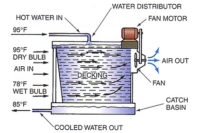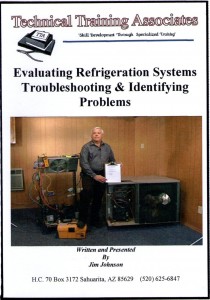Bob is a service technician who is well trained and nationally certified. However, he has sometimes suffered from the same confusion that all technicians occasionally do — the facts that he gathers may or may not point to the obvious cause of the problem or the best solution. But Bob has had something that no one else has. He recalled his long-time HVACR mentor and imagines him accompanying him as “Btu Buddy,” someone who reminded him to take time to stop and think before rushing to judgment, helping keep him on the right track, even with facts that are confusing.
Now, Bob’s company has promoted him to help train a new employee, right out of a school specializing in HVAC, just like Bob was. Bob is now Tim’s Btu Buddy. Tim is anxious to travel with Bob. Tim realizes that he is right out of school, with the theory and lab work that he accomplished in school, but still needs help. He knows that he worked with many of the components of the systems in the school, under ideal conditions with good light and air conditioning. Now it is into the field, sometimes under the house with poor lighting, or out on the rooftop in the sun, where the real action is. He is naturally and normally reluctant, but he has Bob to help guide him.
Bob and Tim were getting set up to clean the condenser tubes in a chiller. They were doing this job at night during overtime hours because they discovered the problem earlier that afternoon and the customer said the chiller needed to be able to operate at full capacity tomorrow for a conference.
They had shut the chiller down for the day and were going to remove the condenser heads so the tubes could be accessed (Figure 1).
Bob said to Tim, “Go to the cooling tower and close off the valve to the make-up water and take the plug out of the tower basin so that it can drain. We will have to clean the tower basin and get the algae cleaned up in the tower. We will need to do that while it is daylight, and then clean the condenser. Be sure to wear rubber gloves, goggles and a mask while doing work in the tower. The algae can be very dangerous to breathe or ingest.”
After Tim had started the tower draining, Bob said, “Open the drain valve on the condenser and let the water drain down the floor drain. Then drain the pump and open the small valve on top of the pump. Notice that the pump is below the condenser; this will be important later on.”
Then Bob said, “Loosen and remove all of the bolts except the two next to the top on the return end of the condenser.”
Tim did the drain job and said, “All bolts but two on the top of the condenser are out. Why leave the two bolts in the cover?”
Bob explained, “This is called a water box cover and it is heavy. We will slowly back the bolts out about ¼ inch and then pry the cover loose and let it hang on those two bolts. We will lift the cover and make sure we have a good grip and can handle the cover. Then we will remove the bolts while holding the cover up, and set the cover on the floor.”
After setting the cover on the floor, they shined a flashlight into the tubes and Tim said, “Sure enough, the tubes are dirty and slimy with algae. Why are the top tubes dirtier than the bottom tubes?”
Bob said, “The water on top is the hottest water returning to the tower and will grow algae faster. Now let’s remove the condenser cover on the other end. It will be much heavier; some of the piping will be hanging on it.”
They removed the cover from the other end. They then moved a machine for cleaning the tubes to one end of the condenser, and connected it to power and a water supply (Figures 2 and 3).
Bob said, “Go to the other end and watch what comes out of the tube that I am going to clean first. I am going to slowly push this rotating brush through the tube.”
Tim said, “Wow, a lot of green junk came out. That is really a mess.”
They brushed all of the tubes, and rinsed them with fresh water. Since only algae was involved, the tubes were thoroughly cleaned.
Tim asked, “How can you tell when a tube is really clean?”
Bob responded, “Since the tubes are copper, if they were bright and shiny, they would be really clean. This can be done with chemicals, but these tubes are old and not shiny. Look at an old penny from your pocket. It is not shiny, but it is clean of any surface buildup. It is brown because it has oxidation of the copper on the surface. Oxidation is so thin that it does not pay to make the tubes shiny like a new penny. It will not interfere with the heat exchange. These tubes should look like an old penny. Examine them from bottom to top and tell me what you see.”
Tim took a very small flashlight and examined the tubes back as far as he could see and said, “They look as clean as a penny to me.”
Bob said, “The water supply in our area does not have many minerals in it, so there should not be any mineral deposits.”
Tim then asked, “Would you explain the mineral deposit problem?”
Bob said, “Almost all water has some minerals in it. Some water supplies have large amounts of minerals. Well water is normally the worst. The minerals can be iron, calcium, sulfur, and more. The cooling tower evaporates water as part of its process. When the water evaporates, the minerals are left behind and the water becomes more concentrated with minerals and these minerals begin to deposit on the copper tubes. These deposits act as an insulator and the heat exchange slows down and the head pressure starts to rise and system efficiency begins to drop.”
Tim asked, “How do you get the minerals off of the tubes?”
Bob said, “Usually an acid or caustic-based solution is circulated through the tubes to soften or remove the minerals. This has to be done very carefully because the acid may also attack the cleaned surfaces of the tubes. It should only be performed by a skilled professional. I have seen the tubes damaged to the point that the refrigerant leaked out of the tubes and water entered the refrigerant side of the system. That is a very bad situation.
“The tubes may need to be brushed out after the chemical solutions have softened the minerals in the tubes in order to get the tubes fully cleaned. Fortunately these tubes only had algae in them and we did not have to deal with minerals.”
Tim then asked, “Suppose this was a mineral-fouled tube situation. What would you do?”
Bob said, “If the tubes were fouled with minerals, I would prefer to call a company that has experts in cleaning tubes with minerals coating the tubes. They would be able to do the job and handle any liability if something went wrong.”
Bob and Tim were through cleaning the tubes and had the ends back on the condenser. All they needed to do was fill the tower and the piping.
Bob said, “Tim, put the plug back in the tower basin and start the tower water source to fill the tower. Watch the little valve on the top of the pump. It will start making a noise as water from the tower begins to fill the piping. The pump is below the tower and will fill as the tower basin fills. Air will rise to the top of the pump and the water will push the air out of it. When water starts to come out of the valve, shut it off. The pump will then be full of water. It has been primed and will be ready to go. When the tower basin is full and the float shuts off the supply water, we will start the condenser water pump and make sure the entire piping system is full of water. Then we will start the chiller.”
Tim asked, “Why can’t we just start the chiller?”
Bob explained, “The condenser may not be full of water yet. The tower is lower than the condenser and the piping has a check valve to hold water in the condenser when it is filled, but we have not filled the condenser yet. If the tower basin does not have enough water capacity to fill the condenser and piping back to the tower, it may draw the tower water too low. When we have established that the complete system is filled with water and it is circulating, we will start the chiller.”
They started the condenser water pump in manual and verified that the system was full of water and then started the chiller. The system was running normally with normal head pressure. They then restored the system to automatic operation and left the job. It was 10 p.m.
The next morning, Tim called the manager and found out the system was cooling as it should. The manager said, “Thank you for staying late and getting this system working again.”
Tim said, “I think we have another satisfied customer.”
Bob added, “You can’t have too many satisfied customers. That is job security.”
Publication date: 7/21/2014
Want more HVAC industry news and information? Join The NEWS on Facebook, Twitter, and LinkedIn today!












